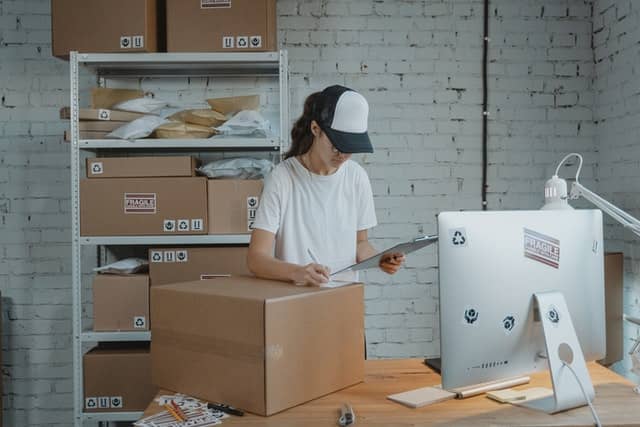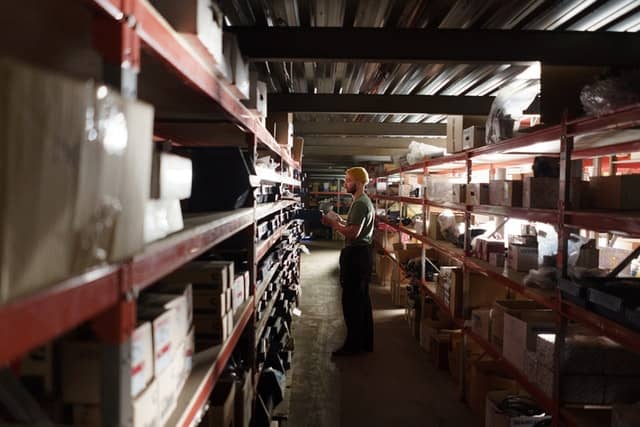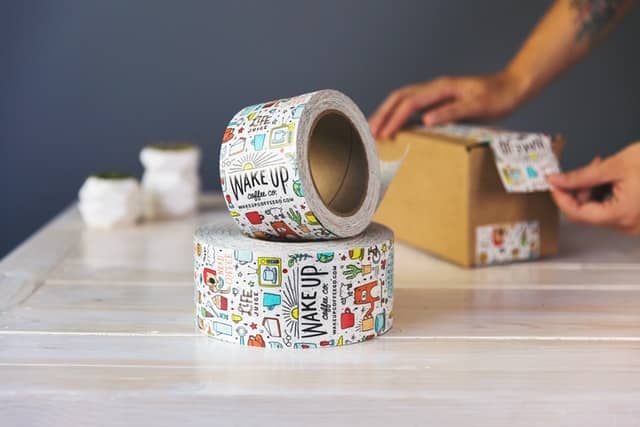Dropshipping and print-on-demand are two popular types of businesses among entrepreneurs in the virtual space. Many mistake one for the other because of similarities in the fulfillment process.
That’s why we’re here to lay out everything you need to know about the two businesses. In this article, we’ll include an overview, main differences and respective pros and cons.
If you’re not too sure about what makes one different from the other, you should definitely read through this article. We’ve also provided recommendations for you to refer to before you make a decision.
Let’s get to it.

Dropshipping vs. Print-On-Demand: Overview
Though seemingly similar, dropshipping and print-on-demand are two different types of businesses, more of which will be discussed later.
So, before we dive into the nitty-gritty details, let’s first get an overview of each.
What Is Dropshipping?
Dropshipping is an order fulfillment method where a business doesn’t keep an inventory of the products it sells. Instead, when customers place orders, these orders will be sent to dropshipping suppliers for fulfillment.
Fulfillment includes processing orders, packing, and shipping the products.
This process shows that dropshipping businesses don’t physically handle their products and aren’t required to order and stock inventory in bulk.
On top of that, you can start a dropshipping business with just an online store.
The products can simply be listed in the store through integrations. Once listed, owners just need to boost their listings to ensure they reach the right customers.
This type of business boasts low start-up costs, appealing to those who don’t want to risk losing a huge sum of money.
With no employees and additional utilities to think about, many have ventured into this type of business model.
What Is Print-On-Demand?
A print-on-demand business is where white label products are sold on a per-order basis. The business will not stock inventory and will work closely with a print-on-demand supplier for order fulfillment.
Let’s expound further on the process, starting with the definition of white label products.
White label products are generic products sold by manufacturers to multiple retailers. Common items include t-shirts, bags, hats, etc.
Through a print-on-demand business, store owners create their own designs to sell and choose white label products to carry them. With that, they look for print-on-demand suppliers to fulfill their orders for them.
So, once a customer places an order, the store owners will then send the order to the supplier. The supplier then processes the order and ships the products directly to the customer.
Dropshipping vs. Print-On-Demand: Main Differences
With overviews out of the way, let’s start to differentiate each business model through its processes and features.

Product Range
Dropshipping and print-on-demand businesses both have wide product ranges. However, these types of businesses differ in the product type they can sell.
Dropshipping stores have the flexibility to sell all types of products, given that these are allowed to be shipped.
On the other hand, print-on-demand stores focus on products they can customize and print on. Common products include clothes and accessories.
Obviously, the product range for print-on-demand is limited compared to dropshipping.
Inventory and Processing Time
More often than not, dropshipping products are mass-manufactured and are ready to be shipped by the time they are in a supplier’s warehouse.
Consequently, dropshipping suppliers hold an inventory of products to ship orders as soon as possible.
For print-on-demand businesses, products are only processed and printed once orders are sent to suppliers. This may add additional business days and cost to the fulfillment process.
Although suppliers already hold inventory for white label products, the printing portion of the process still takes time.
Customization
Given that 90% of US customers prefer brands that offer personalization, let’s take a look at how the two business models include personalization in their own ways.
Between the two, print-on-demand has the upper hand in terms of customization. The designs come from store owners and are printed on the products.
Instead of just having a customized packaging, the entire product itself is unique according to the design chosen.
Dropshipping doesn’t offer much customization because products were already manufactured. If dropshippers want to customize their products, they can explore custom packaging.
Shipping Times and Costs
Generally, shipping times and costs for both dropshipping and print-on-demand businesses are dependent on the location of their suppliers and their chosen third-party delivery services.
However, given that print-on-demand products are made-to-order, it’s expected that these products have longer shipping times than dropshipping—regardless of location and delivery services.

Shipping costs, though, heavily depend on the type of product being shipped. For as long as the product is fragile, large, or heavy, it will cost more to ship.
Profit Margins
Dropshipping products offer more leverage in terms of profit margins. Since these items are mass-produced, the products are more affordable, allowing dropshippers to take home bigger profits.
Dropshipping products also don’t require branding, unless dropshippers decide to do so. Moreover, the entire dropshipping process generates sales and profits much faster than print-on-demand.
Print-on-demand, however, already requires customization before the products are printed.
Although it’s made-to-order, designs aren’t easy to create and require time and effort. Some entrepreneurs don’t consider these as expenses, but it’s important to note that they affect the overall fulfillment process.
Don’t worry though because these customized products appeal to a good target market. If done properly, print-on-demand owners can also reap huge profit margins.
Scaling Opportunities
Both dropshipping and print-on-demand businesses present scaling opportunities.
But dropshipping is easier to scale because it only requires products to be listed on the online store.
Owners can add as many products as they want, for as long as their dropshipping platform allows them. They’re also free to explore different niches to expand their business.
Meanwhile, print-on-demand can only be scaled if more designs are added to the roster.
There’s also a physical limitation when expanding to different product types, given that not many products can be printed. This is why scaling this business, albeit possible, is challenging.
Competition
The dropshipping market is expected to reach $196.78 billion this year. Apart from the low start-up costs, this is one of the reasons why many have ventured into this type of business.
This is also one of the reasons why competition is tough in dropshipping. You’re up against hundreds, if not thousands, of dropshippers, all selling the same products.
Customers have the option to buy the same products from another store.
Unless you sell unique products or offer a great customer experience, you’re pretty much on the same level as other dropshipping businesses.
As for print-on-demand, the competition is pretty low.

Though there’s a risk of plagiarism, print-on-demand products don’t look exactly alike.
You can offer niche products to cater to certain markets, like gamers or hobbyists, and not worry whether they get the same designs and products from other stores.
The bottomline is that print-on-demand’s selling point is its uniqueness. The more creative your designs are, the lesser your chances of being swallowed by the competition.
Dropshipping vs. Print-On-Demand: Pros and Cons
Now that we’ve clearly differentiated one business from the other, let’s look at their respective pros and cons.
Dropshipping Pros
Dropshipping is worth a try, even if you’re new to the business world. Here are its advantages:
Lots of Product Options
One of the reasons why people opt for dropshipping is its product options. You’re not just limited to a specific set of items. Instead, you can sell any item you can think of.
With the right product research methods, most dropshippers easily navigate through millions of products and add preferred products to their online stores.
Even if you’re not familiar with product research, popular dropshipping platforms like AliExpress has features that let you discover and study hot-selling products in the market.
Easy to Scale
As mentioned, dropshipping is easy to scale.
You only need to find the right suppliers and add products to your store. Moreover, the integrations available make it easy for all types of dropshippers.
The ability to generate profits quickly also allows dropshippers to utilize their earnings back into the business to scale it faster.
Short Fulfillment Times
Dropshipping has a shorter fulfillment time because items are ready-to-ship. In most cases, suppliers already hold inventory for their products, lessening the time it takes to fulfill orders.

This proves to be advantageous, especially since consumers expect their products to arrive within two to three days after ordering.
Easy to Start
You don’t need to create designs to start dropshipping. You can just choose products you want to sell and add them to your store. Some suppliers even have product descriptions and photos you can use once products are listed.
Some dropshippers even start their business without a website. Facebook, Instagram, and Pinterest are the top three options to choose from for those who aren’t keen on having a website.
This is why dropshipping is easier to start.
Dropshipping Cons
Despite all the positive sides of dropshipping, there are still some things you should consider before starting your business.
Risky Product Quality
Given the number of product options, product quality isn’t always guaranteed. These items are often mass-produced which makes it harder to enforce quality control.
This is why it’s important to find the best dropshipping suppliers and check the quality of the products before adding them to your store.
You can also partner with reliable dropshipping agents to ensure you source high-quality products.
Highly Competitive
It’s a no-brainer that dropshipping is a competitive industry.
More often than not, you’re selling the same products as your competitors. This makes it a challenge to stand out, especially if you haven’t established your company well enough.
Offering quality customer service and reasonable prices are just two of the things you can do to increase your market share.
Changing Trends
One thing dropshippers may never admit is the fact that it’s exhausting to keep up with dropshipping trends.
The frequent changes can eventually wear down even the most experienced dropshipper. Good for those who have the capacity to hire a team of product researchers.
But for those who are still starting, you might want to prepare yourselves for a bumpy ride.
Print-On-Demand Pros
Print-on-demand, though less popular compared to dropshipping, still offers a couple of advantages worth noting.
Established Branding
Print-on-demand easily lets businesses establish their branding. From custom designs to custom packaging, the products feel far from being generic.

Designs printed on products allow customers to identify and differentiate the business from the crowd. This is advantageous because the consistent presentation of a brand can increase profits by 33%.
After all, customers should remember and prefer your brand so that they consistently buy from you.
Strategic Supplier Locations
Many trusted print-on-demand suppliers are located in the United States and Europe. These locations are ideal, especially if you’re targeting customers in those regions.
Moreover, these regions are also known to offer fast deliveries because of customer demand. The faster items arrive at your customer’s doorstep, the better the reviews.
Easy Cross-Selling and Upselling
Print-on-demand products are often items used daily. With that, business owners can easily sneak in cross- and up-selling opportunities.
Cross-selling is the process of selling an additional or complementary product to a customer. For example, you can suggest adding a tumbler sleeve to a person who’s buying a tumbler.
On the other hand, upselling is the process of selling an upgraded version of a product. For example, if the customer is purchasing a small tumbler, you can suggest a bigger tumbler.
Given the nature of these products, these suggestions won’t seem too out of place, as well.
Print-On-Demand Cons
Print-on-demand has its own fair share of cons, as well.
High Product Cost
Print-on-demand products are made to order, so it’s not surprising that they cost a bit more than the usual dropshipping products on AliExpress or Shopify.
In turn, high product costs translate to higher retail prices which may deter customers from purchasing products.
One thing print-on-demand businesses do is establish a premium brand. This way, they can justify higher-than-average prices for the quality they’re selling.
Creativity Requirement
Creativity is the backbone of a print-on-demand business. Without it, the business would struggle to differentiate itself from its competitors.

All designs must be unique to leave an impression on customers and ensure repeat buyers.
Therefore, before anyone can start a print-on-demand business, they should prepare their creative juices—they’re going to need it.
Dropshipping vs. Print-On-Demand: Recommendations
The main differences and pros and cons are all laid out. It’s time to share thoughts on what type of business is suitable for you.
Let’s start with dropshipping.
Starting a dropshipping business may seem easy, but the competition is tough. It’s not enough that you simply add products to your store. You need to be good at finding them, too.
Therefore, dropshipping is great for entrepreneurs who are diligent enough to look for winning products. This also means keeping up with the trends and making sure you’re never late nor too early.
This isn’t for the lazy ones indeed.
Moving on to the print-on-demand business.
Consider starting a print-on-demand business if you have the creative juices—or at least the capacity to hire someone who has them.
It’s not easy constantly bringing in new designs to the roster, especially when branding is crucial. You have to have a good eye for which designs appeal to your target market.
If you can consistently offer something fresh for buyers, then starting and maintaining a print-on-demand business should be easy for you.
FAQs about Dropshipping and Print-On-Demand
What Are the Best Print-On-Demand Products to Sell?
If you’re considering to start a print-on-demand business, these are some of the trending products you might want to consider selling:

- Tote Bags
- Phone Cases
- Scarves
- Face Masks
- Socks
- Mugs
- Sneakers
- Stickers
- Posters
- Fanny Packs
- All-over Print Yoga Pants
- Hoodies
As you can see, these items can be used on a daily basis. It’s also easy put a premium on these items with the right branding and design.
What Are the Popular Dropshipping Products to Sell in 2022?
As we’ve mentioned, trends constantly change in the dropshipping industry. You should be able to keep up if you want to beat your competitors.
Lucky for you, we’ve compiled a short list of dropshipping products to sell in 2022:
- Wall Clock
- Ear Plugs
- Baby Monitor
- Deep Tissue Massage tool
- Knitted Dresses
- Baby Carriers
- Organic Tea
- Scalp Massager
- Smart Bassinet
- Tripods
- Tamagotchi
- Thermos/Flask
- Drawing Tablet
These items are spread across different niches. Therefore, it’s also great to look into the top dropshipping niches for 2022 if you want to see which ones deserve your attention.
Where to Find Print-On-Demand Suppliers?
Several print-on-demand suppliers are easily found on the internet. These companies are known to provide the best services which is why they’re popular.
Don’t worry, we’ll save you the hassle. Here’s a list of print-on-demand suppliers:
- Printify
- Printful
- Custom Cat
- SPOD
- Teelaunch
- Apliiq print-on-demand
- Lulu xPress
- JetPrint
- T-Pop
- Gelato
- CJDropshipping
Go through each company and see its terms and conditions. It will be best to also consider locations and white label prodcuts available to get the most out of your print-on-demand business.
Where to Find Dropshipping Suppliers?
The easiest way to find dropshipping suppliers by looking them up on Google. You will find several dropshipping suppliers from China, United States, Europe, and other regions.

For convenience, here’s a list of suppliers you can start with:
- NicheDropshipping
- AliExpress
- Oberlo
- Salehoo
- Spocket
- Doba
- LightInTheBox
- DHGate
- Wholesale2B
- CJDropshipping
These dropshippers are reputable and have their unique advantages. Do research and understand which supplier suits your dropshipping store.
Dropshipping vs. Print-On-Demand: Summary
Dropshipping and print-on-demand businesses are indeed becoming popular these days. Both businesses follow similar fulfillment processes, only varying in the initial steps of the process.
We’ve already listed down the pros and cons for each business and it’s now up to you to decide which one’s better for your entrepreneurial appetite.
Again, opt for dropshipping if you can diligently go through thousands of products each day and keep up with the trends.
Timing is essential with this type of business, so it’s definitely not for the lazy ones.
For those considering print-on-demand, better have designs ready. You need to flush out new ones every once in a while to stay appealing to the market.
Unique designs are crucial to success, so make sure designs aren’t plagiarized nor repetitive.
If you ever need help with sourcing your products for dropshipping, feel free to leave us a message. We’ll walk you through our dropshipping services.

